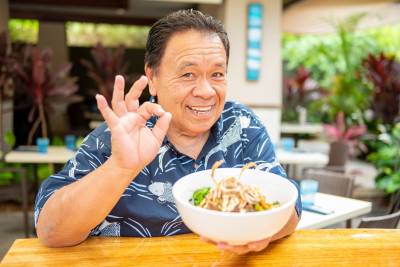Hook, Line & Dinner
 You have worked up a mean hunger after a long, hard day: You surfed all morning, sat poolside all afternoon, and then had to lift several heavy Mai Tais to your lips during happy hour.
You have worked up a mean hunger after a long, hard day: You surfed all morning, sat poolside all afternoon, and then had to lift several heavy Mai Tais to your lips during happy hour.
Now you’re at the Holoholo Grill for dinner, and though the sunset is lovely and your spouse is even lovelier, you only have eyes for the platter of ahi poké in front of you.
This is the handiwork of consulting chef Sam Choy — aka the Godfather of Poké who literally wrote the book on the stuff. The shiny burgundy cubes of raw fish are speckled with toasted sesame seeds and glisten with a secret soy marinade — all laid out like art on green banana leaves. Your spouse uses one of the house-made taro chips to scoop up and feed you your first bite.
Mmmmm. The poké is an umami flavor bomb on your tastebuds, and then just melts in your mouth.
You ponder, Fish and chips, grilled fish, sure. But marinated raw fish chunks? How did Choy come up with this idea?
The answer is centuries in the making.
Fish Tales
If you were hungry in ancient Hawaii, you would grab your spear and head to the nearest ocean — sort of your version of raiding the fridge. The moment you caught a fish, however, it would need to be eaten due to the warm weather, lack of ice and the fact that the Yeti Cooler had not yet been invented. If you caught an extra large reef fish your family might not be able to eat it all in one sitting (unless your in-laws were visiting), so to keep the leftovers fresh you would skin, gut and debone the fish, and “poké” it into chunks. The word “poké” in Hawaiian means “to cut crosswise into pieces.” You would probably season these chunks with some sea salt you’d collected and/or some seaweed to help preserve it a little longer, creating a nutritious, high-protein and delicious snack. Eventually, recipes would be exchanged and you might crush up some kukui nut on top for special occasions.
These seasoned fish chunks were a Hawaiian staple for hundreds of years — usually made with the pale-flesh of accessible reef fish like grouper or omilu. However, as western civilization crept into Hawaii — bringing with it ice boxes and stoves and charcoal barbecues — this once-ubiquitous dish was enjoyed mainly as a regional Hawaiian delicacy.
The Joy of Choy
Flash forward to 1970-something when young Oahu-born chef Sam Choy started to kick the idea of cubed fish up a notch or two. Ahi tuna was becoming more accessible and its dark pink flesh made for a strikingly attractive dish — much prettier than with the paler reef fish. Choy sought out the freshest ahi he could find, “poké’d” it into bite-sized pieces, paired it with a unique marinade and variety of goodies and elevated this once traditional dish into something exciting. People started referring to the dish as “poké” around this time and the name stuck. As one of the founding fathers of the Hawaii Regional Cuisine Movement, Choy continued to bring poké to an even wider audience. With his ever-growing poké empire, Choy is still satisfying taste buds from the islands to the mainland.
“Poké is Hawaii’s king of food,” says Choy. “It’s our soul food.” Choy, who is a James Beard award winner, former chef at the famed Waldorf Astoria in New York City, TV celebrity and Iron chef says that like Michael Jordan or LeBron James he just loves doing what he’s been born to do. And our mouths are all the better for it!
Today you can’t swing a catfish and not hit a poké restaurant in Anytown, US and even across Europe dishing out serviceable versions of this ancient Hawaiian cuisine. But for the real deal, you gotta try the joy of Choy. “The thing is, with my recipes the magic is simple,” says Choy. “When you start with great ingredients, it’s easy to create great food.”
The Holoholo Grill at Koloa Landing is proud to feature its entire menu in collaboration with Sam Choy. Click here to book your stay today and come see what the lure of this fish is all about. You’ll be hooked.
Erica Karlin — Koloa Landing Resort